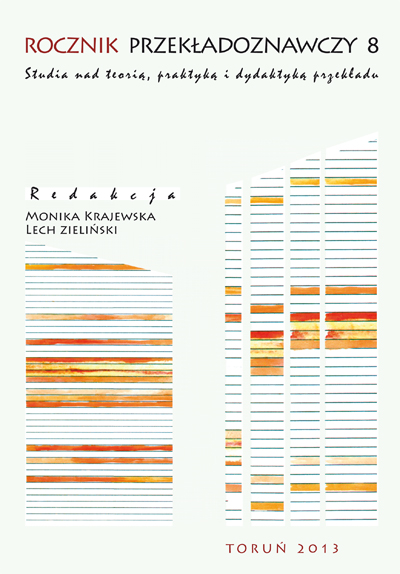The cultural (religious) identity and decisions of the translator
DOI:
https://doi.org/10.12775/RP.2013.003Keywords
translation, cultural context, 16th centuryAbstract
This paper discusses the influence of cultural, especially religious, identity on the translator’s work on the basis of texts rendered in the sixteenth century. The study investigates levels at which the translator interfered in the structure or meaning of the text. The texts analyzed can be distinctly divided into two groups. The first one comprises religious writings which had to be translated faithfully in order to render the meaning of the source text. In this case, the challenge for the translator was the lexis. On the one hand, due to the lack of equivalents of certain referents, the translator had to find a manner of rendering even those passages that described issues which were totally unfamiliar to the Polish culture.On the other hand, they had to decide how to translate proper names. As proper names often both denoted and symbolized certain concepts or items, the translator could try to either render them with Polish appellatives which would reflect their meaning or leave them in the source language. Moreover, the translation was also marked with the style of the source text and the use of language resources. In order to illustrate the issue, the paper presents examples of how sixteenth century translators dealt with finding appropriate linguistic devices to properly render both the meaning and the form of the source text.
The other, entirely different, type of translator’s work was rendering a text which was significantly dissimilar to their culture and religion. In this respect, the paper includes an analysis of selected passages from the Latin textbook entitled Ex P. Terentii comediis Latinissimae colloquiorum formulae..., which had the form of phrases and whose foreign part was based on excerpts from Terence’s comedies. The study presents the translator’s interference in the meaning in order to minimize the discrepancy between the ancient polytheistic religion of the source text and the Christian beliefs of the translator. The examples presented in the paper lead to the conclusion that the translator’s religion and cultural awareness had considerable influence on their conscious decisions to shape the target text in respect of lexis, grammar, style, and meaning.
References
Bieńkowska, D., 1999, Słownictwo i frazeologia w Psałterzu przełożonym przez ks. Jakuba Wujka (1594), Łódź.
Brzozowski, J., Filipowicz-Rudek M. (red.), 2009, Między oryginałem a przekładem XV. Obcość kulturowa jako wyzwanie dla tłumacza, Kraków.
Cieślikowa, A., 1996, „Jak »ocalić w tłumaczeniu« nazwy własne?”, [w:] Między oryginałem a przekładem II. Przekład, jego tworzenie się i wpływ, M. Filipowicz-Rudek, J. Konieczna-Twardzikowa (red.), Kraków, s. 311–320.
Cybulski, M., 1996, Staropolskie przekłady Psałterza [Rozprawy Komisji Językowej Łódzkiego Towarzystwa Naukowego 41, z. 2], Łódź.
Drozd, A., 1999, Arabskie teksty liturgiczne w przekładzie na język polski XVII wieku. Zagadnienia gramatyczne na materiale chutb świątecznych, Warszawa.
Kowalska, D., 2007, „Sposoby wprowadzania przytoczeń w przekładzie Nowego Testamentu J.J. Wujka z 1593 roku”, [w:] Z zagadnień leksykologii i leksykografii języków słowiańskich, J. Kamper-Warejko, I. Kaproń-Charzyńska (red.), Toruń, s. 143–152.
Kulwicka-Kamińska, J., 2006, „Cechy wspólne piśmiennictwa Tatarów litewsko-polskich i kanonu tekstów scs. Geneza. Grafia. Ortografia”, [w:] Varia, t. XIV, M. Olšiak (red.), Bratysława, s. 15–23.
Kwilecka, I., 2003a, „Biblia Leopolity i Biblia Brzeska. Tradycja a nowoczesność przekładu”, [w:] Biblie staropolskie, I. Kwilecka (red.), Poznań, s. 29–37.
Kwilecka, I., 2003b, Studia nad staropolskimi przekładami Biblii, Poznań.
Lisowski, T., 2010, Sola Scriptura. Leksyka Nowego Testamentu Biblii Gdańskiej (1632) na tle porównawczym. Ujęcie kwantytatywno-dystrybucyjne, Poznań.
Luto-Kamińska, A., 2010, „Ex P. Terentii comediis Latinissimae colloquiorum formulae...” Mateusza z Kęt. Studium języka autora na tle polszczyzny XVI wieku, Warszawa.
Łapicz, Cz., Kitab Tatarów litewsko-polskich. Paleografia. Grafia. Język, Toruń 1986.
Moszyński, L., 2003, „Biblia Szymona Budnego. Charakterystyka przekładu”, [w:] Biblie staropolskie, I. Kwilecka (red.), Poznań, s. 41–48.
Pepłowski, F., 1978, „Zmiany językowo stylistyczne w Nowym Testamencie Szymona Budnego z 1574 r.”, [w:] Tekst. Język. Poetyka, M.R. Mayenowa (red.), Wrocław, s. 318–342.
Zarębski, R., 2004, Nazwy osobowe w polskich przekładach Nowego Testamentu, Łódź.
Zarębski, R., 2007, „Tłumaczenie obcych nazw geograficznych w dawnych i współczesnych polskich przekładach Nowego Testamentu”, [w:] Studia nad słownictwem dawnym i współczesnym języków słowiańskich, J. Kamper-Warejko, I. Kaproń-Charzyńska (red.), Toruń, s. 113–123.
Downloads
Published
Issue
Section
Stats
Number of views and downloads: 861
Number of citations: 0



